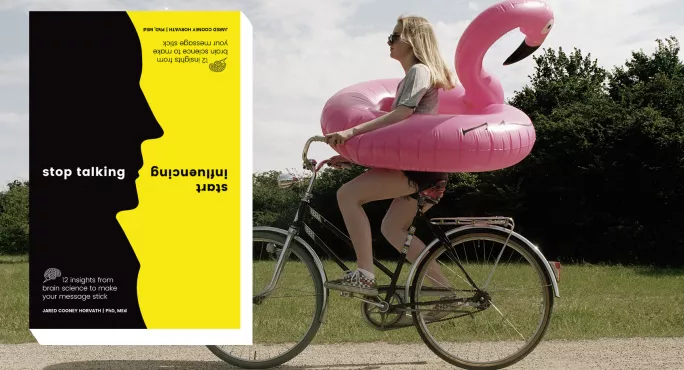- Home
- Book review: Stop Talking, Start Influencing
Book review: Stop Talking, Start Influencing

Stop Talking, Start Influencing: 12 insights from brain science to make your message stick
Author: Jared Cooney Horvath
Publisher: Exile Publishing
Details: £7.99, 304pp, paperback
ISBN: 978-1925335903
We’ve all experienced that crashing disappointment when we’ve really looked forward to something and it hasn’t lived up to our expectations. I was nervous that this might happen to me when I read this book, because I was excited about reading it before I’d even opened it. I’m a teacher who’s interested in how we learn, and this is a teaching book written by a neuroscientist, so I had high expectations for it.
This book was unlike any education book I’d read before, and I needn’t have worried about being disappointed. In fact, when I was about halfway through reading Jared Cooney Harvath’s book, I started worrying that I wouldn’t be able to capture its essence well enough in this review. How do you encapsulate the eccentricities of such a rollicking, joyful ride but still manage to summarise the helpful educational advice within it? This is book gives so much practical advice, but how do you talk about the jokes and smiles you encounter along the way, and explain that neither the entertainment nor the science feel shoehorned in?
I had high hopes for this book. I didn’t want it to just tell me what I should do without explaining why I should do it. I was also hoping to deepen my understanding of neuroscience, and didn’t want to simply be told that something is “evidence-based”. Luckily, this book didn’t let me down: it is practical, accessible and immediately applicable. And Cooney Horvath explains the science behind each recommendation really well.
But what I didn’t expect was the entertainment value offered by the book. It’s quirky and fun and it’s full of stories, illustrations and quips. Yet none of these detract from the solid science at the heart of it all, and it also manages to avoid crossing a line and becoming either irritating or distracting.
Cooney Horvath begins the book by using Picasso drawings to illustrate why it’s important for teachers to understand “why” as well as “what” approaches are effective. And this ethos underpins the whole book. It offers one of the best explanations I’ve read until now for why too much text during a presentation can hinder understanding, combining explanations of the underlying neuroscience with practical tips on how to present things more clearly.
Then it asks questions such as how many images you should include in presentations, if you’re avoiding text, and whether they have to be relevant. The short answer to the latter is that it depends on what you’re trying to achieve with your presentation. Irrelevant images can detract from learning, but they might also engage an audience, which can be a positive in some circumstances. Understanding the science will help you to make decisions in a range of contexts.
Cooney Horvath introduces you to different parts of the brain throughout the book, covering things like why space and context influence memory, and why you absolutely cannot text while driving, but you can chew gum at the wheel. He also explains phenomena like “hearing with our eyes”, by relating how he heard a particularly macabre version of Abba’s Dancing Queen for over 20 years, before finally encountering the true version. But every idea that he introduces is shaped around implications for teaching practice.
The most helpful chapter for me personally was the one about interleaving. This approach is often talked about by teachers, but is seldom understood or applied properly. However, once Cooney Horvath has led you through several examples (and non-examples), it clarifies exactly how you might introduce interleaving in future, and also when you won’t. Do you know, for example, why it’s good to interleave tennis shots during practice sessions, but not to interleave practice for a performance of a Beethoven’s Symphony?
This book also takes you through more familiar territory, such as errors, feedback and misconceptions. But each discussion is rooted in neuroscience, which I found both refreshing and thought-provoking. I also love the way the book demonstrates spaced practice, although I can’t actually tell you more about this without a huge spoiler. But suffice to say it is perfectly summarised by a quote on the back that says “you don’t read this book, you experience it”.
Each chapter ends with a list of suggestions and practical approaches that help you to consolidate what you’ve read and formulate your thoughts. But the last thing you should do is to skip straight to these lists. For a start, you’ll bypass Cooney Horvath’s explanations, which will help you to develop your understanding of neuroscience and learning. But perhaps even importantly, you’ll miss out on all the fun.
This is a book that I’ll come back to again and again for the science, explanations and practical tips. But I might also come back to it and read it again just because I enjoyed reading it. And that was unexpected.
Niki Kaiser is chemistry teacher and research lead at Norwich Research School, Notre Dame High School. She tweets @chemDrK
Keep reading for just £1 per month
You've reached your limit of free articles this month. Subscribe for £1 per month for three months and get:
- Unlimited access to all Tes magazine content
- Exclusive subscriber-only stories
- Award-winning email newsletters



